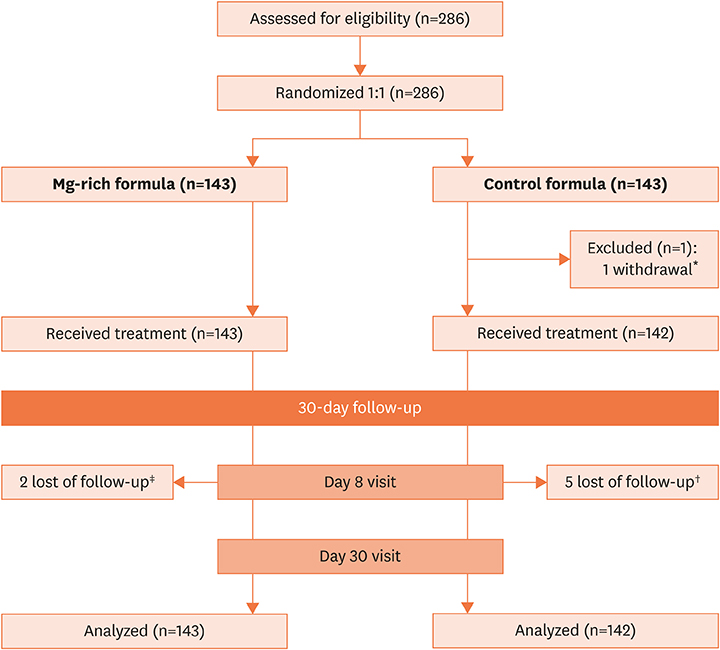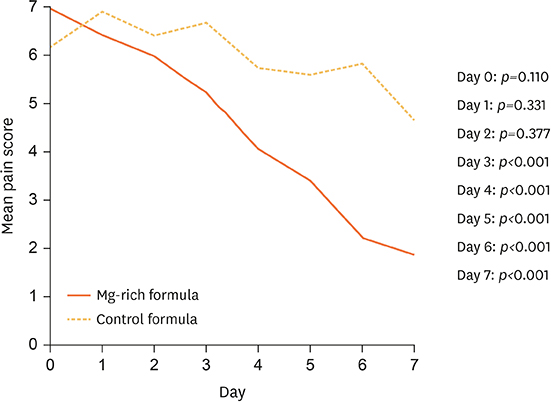Pediatr Gastroenterol Hepatol Nutr.
2019 May;22(3):270-281. 10.5223/pghn.2019.22.3.270.
The Magnesium-Rich Formula for Functional Constipation in Infants: a Randomized Comparator-Controlled Study
- Affiliations
-
- 1Department of Pediatric Gastroenterology, Emma Children's Hospital, Academic Medical Center, Amsterdam, Netherlands.
- 2KidZ Health Castle, UZ Brussel, Vrije Universiteit Brussel, Brussels, Belgium. yvan.vandenplas@uzbrussel.be
- KMID: 2444853
- DOI: http://doi.org/10.5223/pghn.2019.22.3.270
Abstract
- PURPOSE
To compare the effectiveness of the magnesium (Mg)-enriched formula vs. control formula in constipated infants.
METHODS
An open-label, interventional, and the comparator-controlled study was conducted to evaluate the effectiveness of the Mg-enriched formula in formula-fed infants ≤6 months old presenting with functional constipation according to modified Rome IV criteria. Infants were randomized 1:1 to intervention or control formula for 30 days. Parents recorded stool consistency (hard, normal, or watery) and frequency on days 1-7 and 23-29. Physicians recorded patient baseline characteristics and performed the clinical examination at the time of three patient visits (baseline, day 8, and 30).
RESULTS
Of the 286 recruited infants, 143 received the Mg-rich formula and 142 received the control formula. After 7 days, significantly more infants had stools with normal consistency with the Mg-rich formula compared to the infants fed with the control formula (81.8% vs. 41.1%; p<0.001). The number of infants passing one or more stools per day was increased at day 7 in the Mg-rich formula group (86.7% vs. 68.2%; p<0.001). At days 7 and 29, >25% of infants responded completely to the Mg-rich formula compared to <5% of infants fed with the control formula (p<0.001). Parents of infants in the Mg-rich formula group were very satisfied with the treatment (80.8% vs. 10.2%), with the majority willing to continue treatment after 30 days (97.9% vs. 52.6%; p<0.001).
CONCLUSION
The Mg-rich formula significantly improved stool consistency and frequency compared to the control formula in constipated infants.
Keyword
MeSH Terms
Figure
Reference
-
1. Baker SS, Liptak GS, Colletti RB, Croffie JM, Di Lorenzo C, Ector W, et al. Constipation in infants and children: evaluation and treatment. A medical position statement of the North American Society for Pediatric Gastroenterology and Nutrition. J Pediatr Gastroenterol Nutr. 1999; 29:612–626.2. van den Berg MM, Benninga MA, Di Lorenzo C. Epidemiology of childhood constipation: a systematic review. Am J Gastroenterol. 2006; 101:2401–2409.
Article3. Vandenplas Y, Abkari A, Bellaiche M, Benninga M, Chouraqui JP, Çokura F, et al. Prevalence and health outcomes of functional gastrointestinal symptoms in infants from birth to 12 months of age. J Pediatr Gastroenterol Nutr. 2015; 61:531–537.
Article4. Tabbers MM, DiLorenzo C, Berger MY, Faure C, Langendam MW, Nurko S, et al. Evaluation and treatment of functional constipation in infants and children: evidence-based recommendations from ESPGHAN and NASPGHAN. J Pediatr Gastroenterol Nutr. 2014; 58:258–274.
Article5. Biggs WS, Dery WH. Evaluation and treatment of constipation in infants and children. Am Fam Physician. 2006; 73:469–477.6. Rubin G, Dale A. Chronic constipation in children. BMJ. 2006; 333:1051–1055.
Article7. Iacono G, Merolla R, D'Amico D, Bonci E, Cavataio F, Di Prima L, et al. Gastrointestinal symptoms in infancy: a population-based prospective study. Dig Liver Dis. 2005; 37:432–438.
Article8. Tunc VT, Camurdan AD, Ilhan MN, Sahin F, Beyazova U. Factors associated with defecation patterns in 0-24-month-old children. Eur J Pediatr. 2008; 167:1357–1362.
Article9. Çamurdan AD, Beyazova U, Özkan S, Tunç VT. Defecation patterns of the infants mainly breastfed from birth till the 12th month: prospective cohort study. Turk J Gastroenterol. 2014; 25:Suppl 1. 1–5.
Article10. Zanardo V, Gamba P, Menti C, Trevisanuto D. Induction of meconium evacuation and stooling habit development in premature infants: role of gestational age. Minerva Pediatr. 2010; 62:545–549.11. Stewart ML, Schroeder NM. Dietary treatments for childhood constipation: efficacy of dietary fiber and whole grains. Nutr Rev. 2013; 71:98–109.
Article12. Loening-Baucke V, Miele E, Staiano A. Fiber (glucomannan) is beneficial in the treatment of childhood constipation. Pediatrics. 2004; 113:e259–64.
Article13. Tabbers MM, Benninga MA. Constipation in children: fibre and probiotics. BMJ Clin Evid. 2015; 2015:0303.14. Wegh CA, Schoterman MH, Vaughan EE, Belzer C, Benninga MA. The effect of fiber and prebiotics on children's gastrointestinal disorders and microbiome. Expert Rev Gastroenterol Hepatol. 2017; 11:1031–1045.
Article15. Vandenplas Y, Alarcon P, Alliet P, De Greef E, De Ronne N, Hoffman I, et al. Algorithms for managing infant constipation, colic, regurgitation and cow's milk allergy in formula-fed infants. Acta Paediatr. 2015; 104:449–457.
Article16. Mouterde O. Constipation in infants and children: how should it be treated? Arch Pediatr. 2016; 23:664–667.17. Dupont C, Campagne A, Constant F. Efficacy and safety of a magnesium sulfate-rich natural mineral water for patients with functional constipation. Clin Gastroenterol Hepatol. 2014; 12:1280–1287.
Article18. Kinnunen O, Salokannel J. Constipation in elderly long-stay patients: its treatment by magnesium hydroxide and bulk-laxative. Ann Clin Res. 1987; 19:321–323.19. Murakami K, Sasaki S, Okubo H, Takahashi Y, Hosoi Y, Itabashi M, et al. Association between dietary fiber, water and magnesium intake and functional constipation among young Japanese women. Eur J Clin Nutr. 2007; 61:616–622.
Article20. Loening-Baucke VA, Younoszai MK. Effect of treatment on rectal and sigmoid motility in chronically constipated children. Pediatrics. 1984; 73:199–205.21. Loening-Baucke V, Pashankar DS. A randomized, prospective, comparison study of polyethylene glycol 3350 without electrolytes and milk of magnesia for children with constipation and fecal incontinence. Pediatrics. 2006; 118:528–535.
Article22. Ikarashi N, Ushiki T, Mochizuki T, Toda T, Kudo T, Baba K, et al. Effects of magnesium sulphate administration on aquaporin 3 in rat gastrointestinal tract. Biol Pharm Bull. 2011; 34:238–242.
Article23. Lee WT, Ip KS, Chan JS, Lui NW, Young BW. Increased prevalence of constipation in pre-school children is attributable to under-consumption of plant foods: a community-based study. J Paediatr Child Health. 2008; 44:170–175.
Article24. Chao HC, Vandenplas Y. Therapeutic effect of Novalac-IT in infants with constipation. Nutrition. 2007; 23:469–473.
Article25. Infante Pina D, Badia Llach X, Ariño-Armengol B, Villegas Iglesias V. Prevalence and dietetic management of mild gastrointestinal disorders in milk-fed infants. World J Gastroenterol. 2008; 14:248–254.
Article26. Infante DD, Segarra OO, Redecillas SS, Alvarez MM, Miserachs MM. Modification of stool's water content in constipated infants: management with an adapted infant formula. Nutr J. 2011; 10:55.
Article27. Bongers ME, de Lorijn F, Reitsma JB, Groeneweg M, Taminiau JA, Benninga MA. The clinical effect of a new infant formula in term infants with constipation: a double-blind, randomized cross-over trial. Nutr J. 2007; 6:8.
Article28. Moro G, Minoli I, Mosca M, Fanaro S, Jelinek J, Stahl B, et al. Dosage-related bifidogenic effects of galacto- and fructooligosaccharides in formula-fed term infants. J Pediatr Gastroenterol Nutr. 2002; 34:291–295.
Article29. Nowacki J, Lee HC, Lien R, Cheng SW, Li ST, Yao M, et al. Stool fatty acid soaps, stool consistency and gastrointestinal tolerance in term infants fed infant formulas containing high sn-2 palmitate with or without oligofructose: a double-blind, randomized clinical trial. Nutr J. 2014; 13:105.
Article30. Scholtens PA, Goossens DA, Staiano A. Stool characteristics of infants receiving short-chain galacto-oligosaccharides and long-chain fructo-oligosaccharides: a review. World J Gastroenterol. 2014; 20:13446–13452.
Article31. Piemontese P, Giannì ML, Braegger CP, Chirico G, Grüber C, Riedler J, et al. Tolerance and safety evaluation in a large cohort of healthy infants fed an innovative prebiotic formula: a randomized controlled trial. PLoS One. 2011; 6:e28010.
Article32. Closa-Monasterolo R, Gispert-Llaurado M, Luque V, Ferre N, Rubio-Torrents C, Zaragoza-Jordana M, et al. Safety and efficacy of inulin and oligofructose supplementation in infant formula: results from a randomized clinical trial. Clin Nutr. 2013; 32:918–927.
Article33. Sierra C, Bernal MJ, Blasco J, Martínez R, Dalmau J, Ortuño I, et al. Prebiotic effect during the first year of life in healthy infants fed formula containing GOS as the only prebiotic: a multicentre, randomised, double-blind and placebo-controlled trial. Eur J Nutr. 2015; 54:89–99.
Article34. Stiverson J, Williams T, Chen J, Adams S, Hustead D, Price P, et al. Prebiotic oligosaccharides: comparative evaluation using in vitro cultures of infants' fecal microbiomes. Appl Environ Microbiol. 2014; 80:7388–7397.
Article35. Coccorullo P, Strisciuglio C, Martinelli M, Miele E, Greco L, Staiano A. Lactobacillus reuteri (DSM 17938) in infants with functional chronic constipation: a double-blind, randomized, placebo-controlled study. J Pediatr. 2010; 157:598–602.
Article36. Hyams JS, Treem WR, Etienne NL, Weinerman H, MacGilpin D, Hine P, et al. Effect of infant formula on stool characteristics of young infants. Pediatrics. 1995; 95:50–54.
Article37. Salvatore S, Abkari A, Cai W, Catto-Smith A, Cruchet S, Gottrand F, et al. Review shows that parental reassurance and nutritional advice help to optimise the management of functional gastrointestinal disorders in infants. Acta Paediatr. 2018; 107:1512–1520.
Article
- Full Text Links
- Actions
-
Cited
- CITED
-
- Close
- Share
- Similar articles
-
- A Synbiotic Infant Formula with High Magnesium Content Improves Constipation and Quality of Life
- Effects of Antenatal Exposure to Magnesium Sulfate on Neuroprotection in Preterm Infants
- Concentrations of Major Minerals and Trace Elements in Sera of The Breast-fed and Formula-fed Infants
- Medications for Child with Chronic Constipation
- Antenatal Magnesium Sulfate for Neuroprotective Effects In Preterm Infants




